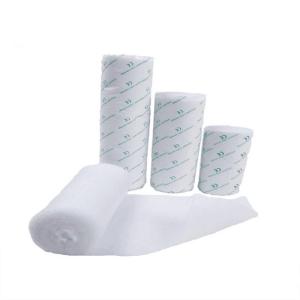

Add to Cart
Cast padding is a material used in the application of casts, providing a layer between the patient's skin and the rigid cast material. The primary purpose of cast padding is to enhance patient comfort, prevent irritation, and promote proper healing. Different types of cast padding are available, including those made from cotton, chemical fiber, and bamboo fiber.
1. Cotton Cast Padding:
- Material: Cotton cast padding is made from natural cotton fibers.
- Characteristics: It is soft, lightweight, and breathable,
allowing air circulation. Cotton is known for its comfort and is
generally hypoallergenic.
- Use: Cotton cast padding is commonly used in orthopedics for casting applications. It provides a cushioning layer between the skin and the rigid cast material, reducing the risk of skin irritation.
2. Chemical Fiber Cast Padding:
- Material: Chemical fiber cast padding is made from synthetic
materials such as polyester or other synthetic fibers.
- Characteristics: It is often designed to be lightweight,
resilient, and quick-drying. Some chemical fiber cast padding
materials may have moisture-wicking properties.
- Use: Chemical fiber cast padding is used in orthopedics for casting, similar to cotton padding. It is chosen for its durability, moisture management, and ability to maintain padding integrity.
3. Bamboo Fiber Cast Padding:
- Material: Bamboo fiber cast padding is made from fibers derived
from bamboo plants.
- Characteristics: Bamboo is known for its natural antimicrobial
properties, breathability, and moisture-wicking capabilities. It is
often considered an eco-friendly option.
- Use: Bamboo fiber cast padding is used in orthopedics for casting applications, providing a comfortable and breathable layer between the skin and the cast material. It may be preferred by those seeking more sustainable and natural options.
Features and advantages
| Item No.: | Padding Size |
| AL22112650 | 5 cm * 270 cm |
| AL22112675 | 7.5cm * 270 cm |
| AL22112610 | 10cm * 270 cm |
| AL22112615 | 15cm * 270 cm |
| AL221126520 | 20cm * 270 cm |
Cast Padding
Applying cast padding is an essential step in the process of
casting for orthopedic purposes. Cast padding serves as a
protective layer between the patient's skin and the rigid casting
material, providing cushioning, reducing the risk of skin
irritation, and enhancing overall comfort.
Cast paddings are padded materials used before the application of the cast to protect any joints or protrusions and other pressure points. They prevent irritation, rubbing, and the creation of sores caused by the cast rubbing against or roughly contacting the skin.
How do you use cast padding?
Apply cast padding by beginning about 1 inch (2-3 cm) beyond the
distal end of the area that will be casted. Roll the cast padding
circumferentially from distal to proximal, making sure to overlap
the previous layer by 50%. This will provide two layers of padding.
Ideally you should have two to three layers of padding.
1. Assess the Skin:
- Examine the skin for any cuts, abrasions, or irregularities. If
there are open wounds or skin conditions, they may need to be
addressed before applying the cast.
2. Measure and Cut Cast Padding:
- Measure the length of the limb that needs to be casted.
- Cut the cast padding material into strips of an appropriate
length, ensuring they are long enough to cover the area to be
casted.
3. Apply Cast Padding:
- Start wrapping the cast padding around the limb, beginning at the
distal (farthest) end and moving toward the proximal (closer to the
body) end.
- Ensure that the padding is applied evenly, avoiding wrinkles or
folds. Overlapping each layer by about 50% helps provide uniform
coverage.
- Pay special attention to bony prominences to provide extra
padding in those areas.
4. Mold the Padding:
- Mold the padding to the contours of the limb, making sure there
are no gaps or uneven areas. This step helps in achieving a snug
fit and even distribution of pressure.
5. Check Circulation:
- Periodically check for signs of impaired circulation, such as
changes in color, temperature, or sensation in the fingers or toes.
Adjust the cast padding if needed to alleviate pressure points.
6. Prepare for Casting Material:
- Once the cast padding is applied, prepare the casting material
according to the manufacturer's instructions. This may involve
dipping fiberglass or plaster of Paris rolls in water.
7. Apply Casting Material:
- Begin applying the casting material over the cast padding. Ensure
that the casting material is distributed evenly, covering the
entire length of the cast.
- Overlap each layer of the casting material to provide strength
and rigidity.
8. Mold and Shape the Cast:
- Mold and shape the cast to achieve the desired form and support.
Smooth out any rough edges or irregularities.
9. Allow the Cast to Dry:
- Follow the specific instructions for the drying or curing time of
the casting material. This may involve waiting for the material to
harden or set.
10. Evaluate the Final Cast:
- Once the cast is fully dry and set, assess its fit, comfort, and
overall integrity. Ensure that the patient can move their fingers
or toes as appropriate for the type of cast applied.
What is undercast padding bandage?
Undercast Padding is a synthetic and protective material which blends excellent conformability and good cushioning. The padding tears and moves easily around awkward contours, minimising patient trauma and enhancing ease of application for the clinical user. Features & Benefits.
